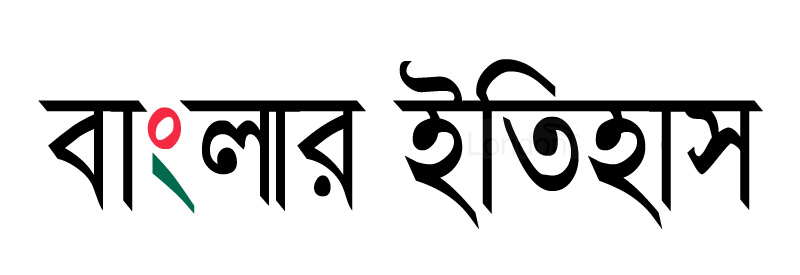
Bangla over 1,000 years old
Last updated: 5 October 2017 From the section 1952 Bhasha Andolon
Bangla or Bengali is an eastern Indo-Aryan language (a branch of the Indo-European language family) which is native to the country of Bangladesh and Indian state of West Bengal, and parts of the Indian states of Tripura, Assam and Jharkand.
In English, 'Bengali' is also used to define the speaker of the language.
Origin
Bangla or Bengali is written in its own script and has grown over a period of one thousand years from the Magadhi Prakrit, which developed from the Sanskrit language and dates back to the Aryan days (1200 BC). Some scholars believe that Bangla is much older, perhaps going back to even 500 BC. They claim that the emperor Asoka (c. 269 BC), and even Lord Buddha (c. 563 BC), occasionally used a certain type of Bangla "Lipi" while communicating with their subjects and disciples in the eastern regions of this subcontinent. A research-paper written by Dr. Mohammed Rezaul Karim in 2007 claimed that the first inscription in Bangla was made by Mohammed Bakhtiyar Khilji in 1205 when a bi-lingual coin was issued in Gour with the words "Gosur Bijoy" inscribed on it in Devnagri script.
'Language of the untouchables' during early Hindu rulers
In the pre-Aryan days, the people living in Bengal were of Dravidian, Mongolian, Bhot-Chin or Kolomboda origin. They used to speak in Dravidian, Bhot-Chin or Munda languages.
It was in Gupta era (320-550) that Bengal had first contact with the Aryan civilization. But before any intimate or effective acquaintance could be established with the Aryan civilization, the kings from the Pala Dynasty (900 - 1100) turned Bengal into one of the citadels of Buddhism. Bangla language evolved within this environment from a distorted version of Prakrit and became associated with the lower caste of the Indian society, the 'untouchables'.
Buddhist Charyapada (also known as Charya-Charya Binischaya), a collection of 47 mystical poems totalling 480 lines, originated during the Pala rule and is believed to be the oldest specimen of Bengali literature. However, the language of the Charya-Charya Binischaya, now referred to as Charyapads, was "but poor fragments of the literature" which owed its origin "chiefly to earnestness of Tantrik Buddhists for popularizing their creed and which was just evolving out of Laukika".
The Aryans realised that the first step to pollute or cripple a culture is to destroy or distort its language. As a result of systematic oppression by the Sanskrit and Prakrit speaking people the innocent indigenous inhabitants of Bengal started forgetting their languages. But Sanskrit was no effective spoken language, almost everything it had at the time was in black and white. So a section of the people started speaking in a particular type of Prakrit known as Gouriya-Prakrit. The Gouriya-Prakrit being used by the non-Aryans, Dravidians, Kot-Chins, Mundas and Kols took a distorted form and many a word from their dialects had slow but steady access into it. Slowly and silently this distorted form of Gouriya-Prakrit (Gouriya Apabhramsa) gave birth to ancient Bengali language. But the people who used to speak in this ancient form of Bangla were looked down upon as an inferior caste by the Aryans. It was claimed that anyone who spoke in this 'disgraceful' dialect of the untouchables would inevitably go to hell. It is really unfortunate that although Bengal reached the peak of glory in almost every domain of thought during the reign of Gopal Dev and his descendants, who ruled over this part of subcontinent for more than three hundred years, the Bangla language could not make any remarkable progress. The reason was plain and simple - the then Hindu society always despised and hated this 'ignominious dialect of the untouchables'. Written form of Bengali was yet to come.
The Daily Star (Bangladesh)
After the Pala Dynasty came the Sena Dynasty who ruled over Bengal for over one hundred years (from 1070 - 1230). The Sens also considered Bangla as the language of the untouchables.
In 1931 a limestone slab, approximately 4.4cm x 5.7cm and bearing six lines in Prakrit in Brahmi script, was discovered in Mahasthangarh by a day labourer named Baru Fakir. This Mahasthan Plaque, as it became known, contains inscription about famine of Ancient Pundra Nagar, possibly during the rule of emperor Asoka, and dates Mahasthangarh to at least the 3rd century BC. It is the earliest evidence of "primitive" Bangla and testifies to the antiquity of the Bangla language.
Royal patronage by Muslim rulers ushers in new era for Bangla and accelerated growth
It was the conquest of Bengal by the Muslims in 1201 which ushered in a new era for Bangla, providing it a congenial environment and proper facilities to thrive into a major language. When the Muslims first conquered Bengal there was hardly any Bengali literature worth the name. Nor was the language cultivated by the educated class.
Where, once the Hindu and Buddhist culture were most influential, gradually evolved the Islamic culture. Persian, as the Muslim court language, became the most influential language and for more than 600 years (1203 - 1837) remained as the official language in Bengal. The importance of the Brahmins and their Sanskrit language gradually declined.
Whatever might be the exact date of the Charyapads it is generally recognized by scholars that no vernacular language could have found a scope for free literary expression under the Brahmanical system which preceded the coming of the Muslims and which interdicted the study of any but the Sanskrit language. A well-known Sanskrit Sloka (couplet) states that if a person hears "the stories of Ashtadash Puranas or of the Ramayana recited in Bengali, he will be thrown into the hell called Raurava" Bangla, "the language of the untouchables" would have surely been nipped in the bud had there been no patronage from the Muslim kings like Sikander Shah, Hussain Shah, Yusuf Shah, Barbak Shah and Paragol Khan.
The Daily Star (Bangladesh)
Unlike the Hindu Brahmins the Muslim rulers were liberal in their outlook. They introduced meritocracy and spread knowledge by breaking it from the bondage of caste system. This meant that the Brahims no longer had monopoly of knowledge and literary activities and everyone - Muslim, Hindu, rich, poor, man, woman, etc - were eligible to acquire it. The strict adherence to the doctrine of equality practised by the Muslim progressively brought a social revolution and people were employed in official position according to their merit.
Blessed with the royal patronage the swelling waves of Bangla started reaching every nook and corner of Bengal. It encouraged the masses to become educated. During subsequent rule by Muslim rulers they promoted the Bangla language and even gave it status of a state language though it was not an official language in Mughal and British rule. Ramai Pundit, an influential medieval Bengali poet who lived around the 11th century, eulogized in unequivocal terms the Muslim conquest of Bengal as a heavenly bliss. In 'Niranjaner Rushma' (Anger of Niranjan), a section of his Shunnya Purana, the Muslims are portrayed as Religious Incarnate releasing people from the tyranny and oppression of the Brahmins and the Sen rulers.
The Muslims not only welcomed Bangla with an open heart but they literally gave a new birth to this hitherto neglected language. By 1350, Muslims had united different regions of Bengal and started becoming patrons of Bengali language and literature, thus providing an impetus to new literary productions in Bengali.
The Daily Star (Bangladesh)
"Ami Banglai Gaan Gai" by Pratul Mukhopadhyay
Cultural mix
Bangla incorporated many Arabic, Persian, Turkic, Dutch, French and English words when the Bengal region came in contact with these foreign powers.
| Word | Translation |
|---|---|
| Hello | Assalamualaikum/Slamalikum (Muslim form, M), Namoshkar (Hindu form, H) |
| Invitation | Daoat (M), nimontron/nimontonno (H) |
| Water | Pani (M), Jal (H) |
| Meat | Gosh/goshto/gosto (M), mangsho (H) |
| Prayer | Dua (M), prarthona (H) |
| Salt | L'bon (M), nun (H) |
| Turmeric | Holud (M), holdi (H) |
| Chili pepper | Morich (M), l'ngka (H) |
| Paternal uncle | Chacha (M), kaka (H) |
| Arabic influence | Dukan (shop), tarikh(date), kolom(pen), bonduk (gun) |
| English influence | Teble (table), tiffin (snack box), television, telephone, video, radio |
Source: Various
Advancement
During the rule of powerful Mughal and British empires Bangla continued to flourish among the upper strata of Muslim and Hindu population. The Bengali Renaissance (circa 1775 – 1941) witnessed great advancement in the use of the language and exposure to a larger audience. Reformist, inventors, and writers such as Ishwar Chandra Vidyasagar who reformed the Bangla prose literature, Girish Chandra Sen who was the first to translate the Holy Qur’an into Bengali, and Delawar Hosaen, the first Muslim graduate of Calcutta University, made extensive use of Bangla to spread their knowledge.
The first non-European ever to win a Nobel Prize was Rabindranath Tagore who had been awarded the prestigious accolade in 1913 for his book Gitanjali (Song offerings) – a rich collection of poetry written in Bangla. He also wrote the national anthem of Bangladesh (Amar Shunar Bangla) and India (Jana Gana Mana) both in Bengali.
Other Bengali Nobel Prize winners include Amartya Sen (Nobel Prize for Economics in 1998) and Muhammad Yunus (Nobel Prize for Peace, and also for his Grameen Bank, in 2006). Muhammad Yunus also became the first Bengali from Bangladesh to win it.
National Poet of Bangladesh include Kazi Nazrul Islam, the 'bidrohi kobi' (rebel poet) who conquered the hearts and minds of people writing in Bangla.
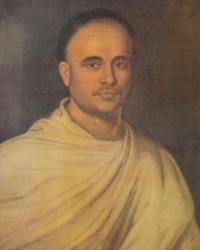 Ishwar Chandra Vidyasagar ()
Ishwar Chandra Vidyasagar () 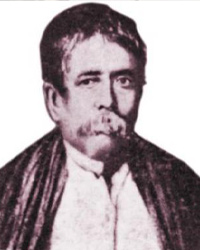 Girish Chandra Sen ()
Girish Chandra Sen ()  Delawar Hosaen ()
Delawar Hosaen () 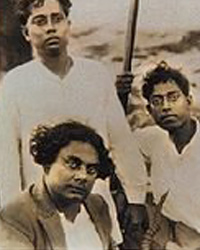 Kazi Nazrul Islam ()
Kazi Nazrul Islam () 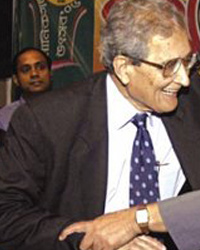 Amartya Sen ()
Amartya Sen () 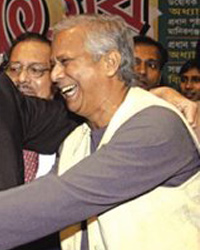 Muhammad Yunus ()
Muhammad Yunus ()
During the Bhasha Andolon Bengalis were quick to point out that their language was equally developed – if not, even more advanced – than the Urdu language and was widely spoken in East Pakistan (previously called East Bengal).
Bangla belongs to the procession of life, making constant adjustments with surprises, exploring unknown shrines of reality along its path of pilgrimage to a future which is as different from the past as the tree from the seed.
The beauty of Bangla as eulogised by the great maestro Rabindranath Tagore
The Bengali community as a whole is renowned for its hospitality, its political awareness and love for discussions (adda) and civic engagement, and for its demonstrated admiration for poetry (both reading and writing).

